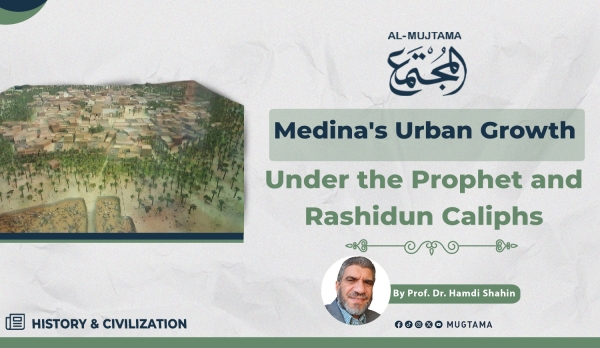Reflections on Urban Development in Medina: Prophethood and Rightly Guided Caliphs Era
The issue of integrating the immigrants into the city was one of the most significant challenges faced by the Prophet Muhammad (peace be upon him) following his migration there. The Ansar (the helpers from Medina) were quick to offer assistance in this matter, as they designated for the Messenger of Allah "every land that is not reached by water, for him to do with it as he wishes," as well as "the patches of land that have been neglected," meaning the land that had deteriorated from prolonged abandonment. They also offered him inhabited and prosperous areas, allowing him to take from them as he pleased. As a result, many lands emerged from which the Prophet allocated to the migrants, and he established quarters, assigning each tribe its own area to maintain their social bonds and alleviate the feelings of alienation in their new homeland.
From the mosque - which is the heart of the city and its center - main streets extended, connecting it to the four corners of the city. Additionally, side streets branched off, penetrating into the areas of the Ansar and the Emigrants, making it easier to reach the Prophet's Mosque at the center.(1)
It has been mentioned that the Prophet granted some of the companions vast lands for cultivation and construction, including the grant of Al-Aqiq to Bilal ibn Al-Harith. However, he was unable to develop these lands, so Umar ibn Al-Khattab took them away from him and granted them to other Muslims. The land of Al-Aqiq is located a distance west of the Prophet's mosque. Umar was eager to promote development in these areas to reduce population concentration in the heart of the city. This was indeed achieved, as a group of companions settled in the areas of Al-Aqiq, including Sa'd ibn Abi Waqqas, Sa'id ibn Zayd, Abu Huraira, and Sa'id ibn Al-A'as. Sa'd ibn Abi Waqqas, Sa'id ibn Zayd, and Sa'id ibn Al-A'as died there and were transported to the city, where they were buried in Al-Baqi
During the caliphate of Uthman, the area of the city expanded, and the homes spread to fill the vast gaps between its neighborhoods. The center of the city connected with its outskirts, and buildings reached Mount Sal' in the northwest, extending beyond it to houses near the Mosque of the Two Qiblahs. The area between Quba and Al-Awali in the south also connected, and the houses extended to the edges of the valley of Al-Aqiq in the west.
Read also: Choosing the location of the first capital of Islam and its planning.
By examining what has been mentioned about the homes of the companions during this era, several concepts can be established:
- The simplicity of these buildings, especially in the early days of the Rashidun Caliphate, was influenced by the simplicity of the Prophet's houses, a preference for asceticism, and a preoccupation with the burdens of calling and jihad. Al-Bukhari and Ibn Majah narrated from Ibn Umar, may Allah be pleased with them both, who said: "I found myself with the Prophet, and I built with my own hands a house that sheltered me from the rain and shaded me from the sun, and no one among God's creation assisted me in it." His lack of need for assistance is evidence of his simplicity and low cost.
- Omar ibn Shabah narrated that Ammar ibn Yasir went to Sham as a warrior and settled in Homs. He then wrote to Umar ibn al-Khattab, informing him that he intended to perform Hajj and asking him to build his house in Medina before his arrival. Umar built it and personally oversaw the construction, sometimes handing the workers clay bricks with his own hand. When Ammar returned, he found the house completed and he was impressed by it and expanded it. He said, "I only wanted a place to shelter my head and to tie my mount until I return to my station.
- They then expanded their homes after their economic conditions improved, with the continued conquests and the influx of spoils. Some of their houses were spacious enough to be divided into two homes. Ibn Shabah also narrated that Al-Zubair ibn Al-Awwam had a house on the western side of the mosque, which he divided between his two sons, Omar and Urwah. Similarly, the house of Talha ibn Ubaydullah, also to the west of the mosque, was divided among three of his sons after his death in the Battle of the Camel in the year 36 AH.
- Most of the houses of the companions were single-story, but some were two-story, like the house of Abu Ayyub al-Ansari, where the Prophet stayed after the Migration, and he lived in the upper floor. There was also the house of Khalid ibn al-Walid, who complained to the Messenger of God about the narrowness of his home, to which the Prophet replied, "Make space in the sky," meaning to build an upper floor.
- Some of the Companions owned more than one house, especially those among them who were affluent. For instance, we see that Abu Bakr Al-Siddiq had one house on the alley of Al-Aqiq, another next to the Prophet's Mosque, and a third in Al-Sunh among the Banu Al-Harith bin Al-Khazraj. Uthman bin Affan had two houses to the east of the mosque that were connected to each other, one of which was larger than the other. Likewise, Abd al-Rahman bin Awf owned several houses, three of which were included in the expansion of the Prophet's Mosque. Lady Umm Habibah, the wife of the Prophet, had a house to the north of the mosque, in addition to her chamber among the chambers of the Mothers of the Believers, according to the narration of Al-Samhudi. Al-Zubair bin Al-Awwam owned eleven houses in Medina, and Abu Rafi, Mawla of the Prophet, had two houses which he sold to Sa'd bin Abi Waqqas.
- The Islamic principle of mutual support continued among the companions of the Prophet. Some of those who were able gifted one or more houses to those in need among the companions. For instance, Um Habiba, the wife of the Prophet, dedicated a house of hers to Shurahbil ibn Hasana, which became known as the House of the Al- Shurahbil family. Likewise, Um Salama gave one of her houses to Ammar bin Yasir, and Khalid bin Al-Walid endowed his house in Medina so that it would neither be sold nor gifted.
Among the aspects related to urban thought at that time was the practice of using designated areas outside the residential zones for relieving oneself; this was done out of a dislike for doing so in homes, in order to maintain cleanliness and pleasant scents. This is mentioned in the narration of Aisha (may Allah be pleased with her) in the story of the slander: "We were disturbed by the use of keneef (toilets) being placed near our houses." They referred to those spots for relieving oneself outside the homes as "manasi'" (مناصع), which means "a spacious area of land," and there was an alley leading to it known as the alley of manasi
Also, taking care of the cleanliness of the streets and houses, so that they present a harmonious appearance in line with what Islam commands regarding cleanliness and beauty. When Umar ibn al-Khattab entered Mecca, he would walk through its alleys and say to the residents of the houses: 'Clean your courtyards.(2) But he ordered his governors over the cities, when Abu Musa al-Ash'ari, may Allah be pleased with him, came to Basra and said to them, as narrated by Ibn Abu Shaybah in his compilation: 'Indeed, the Commander of the Faithful sent me to you to teach you your Sunnah and to clean up your paths
It is inconceivable that Omar would neglect the matter of cleanliness in Medina while attending to it outside the city. He came to the Quba Mosque on his horse, prayed there, and then said to his servant: "O Yirfa, bring me a palm frond." The servant brought it to him, and Omar held his garment back, then swept it (this was reported by Ibn Abi Shaybah). In fact, one of Omar's Mawla, named Abdullah, became known as the "Mujammir" because he would perfume the mosque with incense whenever Omar sat on the pulpit(3)
As for the city parks and places for relaxation, the most notable among them are the gardens around water wells, including Wadi Al-Aqiq when its water flows.
One example of this is when the year of Ramada ended and it rained, and the valleys flowed. Umar went out with some of his companions to Al-Aqiq to witness the rushing flood after the severity of the drought(4)
- Othman: The reference itself, p. 51.
(2) Al-Mutaqi Al-Hindi: Kanz Al-'Umal 12/667.
(3) Ibn Abdul Barr: Al-Tamhid 16/177.
(4) Ibn Hajar: Al-Isabah fi Tamyiz Al-Sahabah 2/141.


